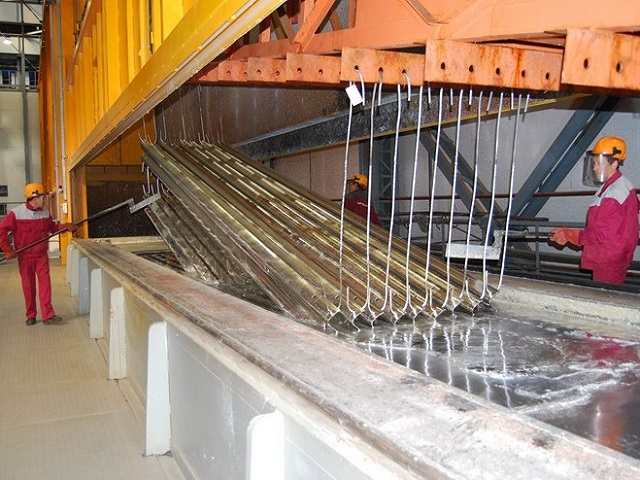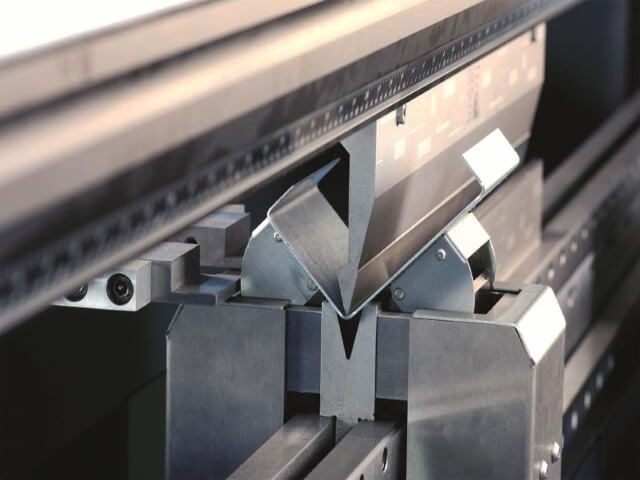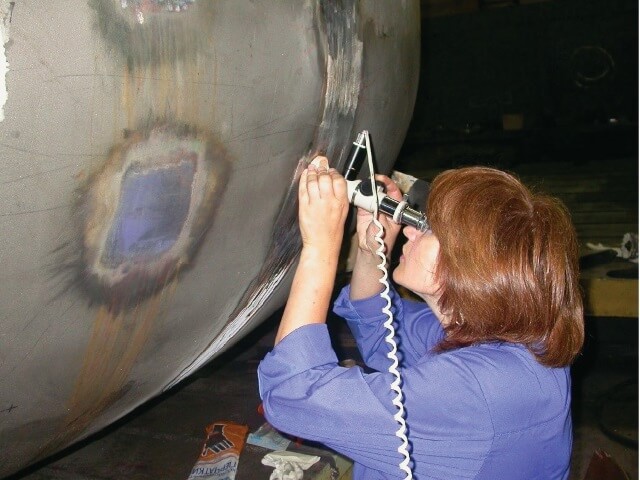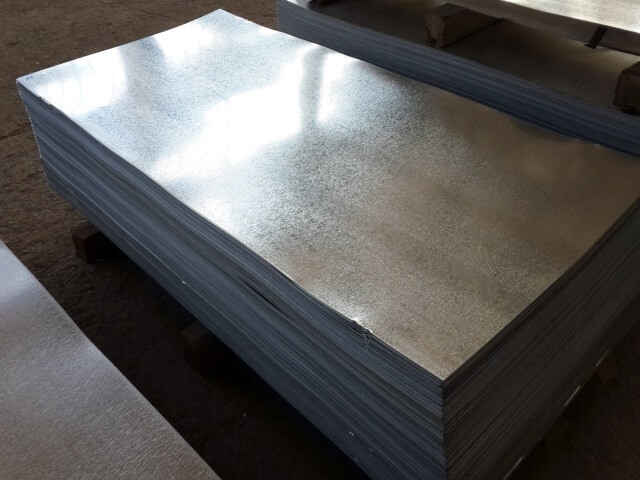Ultimate Guide to Galvanized Steel: Quality Control, Parameters, and Applications in Construction
Galvanized steel is a material widely used in the production of items for construction and finishing work. Specifically, galvanized steel sheets serve as the primary raw material for manufacturing facade panels, metal fence components, and more.
The quality of the galvanization directly impacts not only the mechanical properties of the products but also their durability. A high-quality zinc coating prevents corrosion, ensuring that facade panels, ceiling rails, and metal fence slats can last for an extended period, even with regular exposure to moisture and temperature fluctuations.
Galvanized Steel Parameters
Choosing high-quality galvanized metal for any product manufacturing is crucial. While low-grade products may be cheaper, their poor zinc coating quality often leads to reduced corrosion protection. As a result, the perceived cost savings are illusory: products begin to rust much sooner, requiring repair or replacement.

Quality Standards for Galvanized Steel
The quality of galvanized metal is determined by several standards, the most important of which are:
- GOST R 52246-2004: “Hot-dip galvanized sheet metal.”
- GOST R 52146-2003: “Cold-rolled and hot-dip galvanized thin-sheet metal with polymer coating from continuous lines.”
- GOST 14918-80: “Continuous line galvanized thin-sheet steel. Technical conditions,” and others.
These documents outline the requirements that galvanized steel must meet. In this section, we’ll briefly discuss the most critical parameters.
The first aspect is the quality of the steel base. Any products can be galvanized, but for manufacturing profiled products, sheet steel with a thickness ranging from 0.4 to 2.0 mm is used. The ideal option is to use metal intended for cold stamping (CS) or cold profiling (CP). General-purpose steel (GPS) is also acceptable.

Types of Coatings
The next important detail is the type of applied coating:
- Hot-dip zinc coating (HDZ) is most commonly used in the production of construction and finishing materials.
- Sometimes, as an alternative, hot-dip iron-zinc coating (HDI) is also applied.
However, the key parameter affecting both the coating’s strength and its effectiveness in corrosion protection is the coating thickness. Based on this parameter, galvanized steel is divided into three classes.
| Class | Zinc Coating Consumption, g/m2 | Zinc Layer Thickness, μm |
| 2 | 142,5-258 | 10-18 |
| 1 | 258 – 570 | 18-40 |
| P (enhanced) | 570-855 | 40-60 |
The higher the coating class, the higher the cost of the metal (and consequently, the products made from it). However, this also means greater reliability and effectiveness in protecting the steel base from corrosion.
Laboratory Control Methods
Determining the quality of the protective zinc coating is a crucial task for quality control staff and companies that produce raw materials, as well as those involved in processing such metal. Quality control methods are described in GOST 9.307-89.

Here are the most commonly used technologies:
- Magnetic Method for Measuring Zinc Coating Thickness: This method is based on detecting changes in magnetic resistance depending on the thickness of the coating. Magnetic thickness gauges are used as measuring devices. The relative error of this method is approximately +/-10%.
- Metallographic Method for Coating Thickness Control: A sample is cut from a galvanized sheet or finished product, which is then ground to obtain a clear cross-sectional image. The ground section is examined under a microscope with measurements taken.

- Gravimetric Method for Coating Quality Assessment: This method involves comparing the mass of a sample before coating and after treatment or comparing the mass of a treated part after zinc coating and after removing the zinc coating using a solution of stannous chloride.
- Control of the Chemical Composition of the Zinc Plating Bath (the zinc content should be at least 98%).
- Adhesion Quality Control of the Coating to the Substrate: This can be done by applying a grid of scratches to the surface (using a steel blade with a spacing of 2 to 3 mm and a depth to the steel substrate). A coating with a thickness of up to 50 µm is considered good if the zinc does not peel off between 5-7 scratches.
- Heat Test Method: A sample, whose quality is being tested during the experiment, is heated to 190°C and held at this temperature for 45-60 minutes. After cooling in the air, there should be no delaminating or swollen areas on the surface of the zinc protective layer.
HOW TO ASSESS STEEL QUALITY YOURSELF?
The main drawback of most laboratory methods used for checking the quality of zinc coating is their high complexity. It is often impossible to implement them “at home,” so when purchasing raw materials or finished products, customers often rely solely on the product labeling provided in the documents.
However, it is still possible to assess the quality of galvanizing, even approximately, outside the laboratory, and it can be done in just a few minutes. The most simple, accessible, and reliable method is visual inspection (which is also used in quality control according to industry standards).
During visual inspection, pay attention to:
- Uniformity of Zinc Application: If there are untreated areas on the surface of the sheet or product, it indicates poor surface preparation for galvanizing. Corrosion is most likely to develop quickly on these areas.
- Absence of Thickness Variations: The visual thickness of the zinc coating should be approximately the same across the entire surface.
- Absence of Defects: Defects include blisters, runs, wrinkles, inclusions, porous areas, etc. The presence of such artifacts in significant quantities indicates poor manufacturing practices, often caused by impurities in the zinc coating material.
- Uniformity of the Zinc Coating Pattern: Depending on the composition used for galvanizing metal, the pattern may vary (in terms of color, pattern, gloss, texture). It’s important that these parameters are consistent across the entire treated surface.

Visual assessment of the coating thickness is also possible. Yes, thin-layer application makes it difficult to assess quality accurately without using special instruments (micrometers, thickness gauges). Therefore, it is advisable to:
- Either purchase a specialized thickness gauge that allows you to work with zinc and zinc-iron coatings. Such devices are often sold in auto shops for checking the quality of corrosion protection for vehicle bodies.
Or estimate the thickness of the galvanizing by comparing it with a reference sample (accuracy will still be low, but better than without a reference).

Another “folk” method is the mechanical assessment of strength. In simpler terms, a steel tool is used to try to scrape off the zinc coating from the metal substrate (similar to the scratch grid application described in the industry standards). If the metal is of sufficient quality, hardened steel can certainly scratch the galvanization (especially with enough force), but it won’t lead to material delamination. However, when the hot-dip galvanizing process is compromised, the coating will detach from the substrate in characteristic patches.
The downside of this method is that it is indicative, meaning it can only distinguish very low-quality galvanized steel. On the other hand, when purchasing relatively cheap raw materials, this method can help identify the most obvious defects.
EFFICIENT WAYS TO CHECK THE QUALITY OF THIN SHEET METAL
Experienced builders know how important it is to have reliable and high-quality thin sheet metal for construction and industrial projects. Choosing the wrong metal can lead to bending problems, corrosion, and even safety hazards. Here are expert tips on checking the quality of thin sheet metal to help you make the right choice and ensure the reliability of your project.
- Thickness Check: The thickness of thin sheet metal is one of the most critical quality criteria. Use a micrometer or other precise measuring instruments to determine the actual metal thickness. Verify whether the stated thickness on the label or in technical documents meets the requirements. Remember that even slight deviations can affect the strength and durability of the metal.
- Chemical Composition: The correct chemical composition of thin sheet metal is a key factor in its quality. Ensure that the chemical composition meets your needs and project requirements. Compare the declared composition with national and international quality standards. Consider proportions of essential elements such as carbon, manganese, silicon, and other impurities as they influence the metal’s properties and wear resistance.
- Surface Quality: Special attention should be paid to the surface quality of thin sheet metal, as any defects can worsen its functionality and appearance. Examine the metal in bright light, looking for scratches, grinding marks, unevenness, and other defects. Some standards have established quality categories for surfaces that can be used for comparison.
- Strength and Durability: Choosing metal with high strength and durability is essential for any project. Familiarize yourself with yield limits, tensile strengths, and impact resistance properties of the metal. These indicators show its ability to withstand loads, resist damage, and maintain crack resistance.
- Certification and Standards: Ensure that thin sheet metal has the appropriate certificates and meets national and international quality standards. Check whether the metal is certified by relevant authorities and whether it complies with the requirements of your project. Carefully review all documents and certificates confirming the quality and origin of the metal.
Quality control of thin sheet metal can be carried out using various instruments and tools. Below are several key instruments that can be used to assess the quality of thin sheet metal:
- Micrometer: A micrometer is a measuring instrument that allows for precise measurement of the thickness of thin sheet metal. It provides measurements in millimeters or micrometers and enables accurate measurements of the distance between opposite surfaces of the metal.
- Fluorescent Lamp: A fluorescent lamp is used to inspect the surface of thin sheet metal to detect irregularities, including cracks, scratches, and other defects. It emits special light that reveals even the tiniest damages, helping identify potential quality issues.
- Ultrasonic Thickness Gauge: An ultrasonic thickness gauge (also known as a flaw detector) is used to detect internal defects in thin sheet metal, such as cracks, voids, air inclusions, etc. This device generates high-frequency sound waves that penetrate the metal and return based on defects. The results are analyzed to identify and assess quality problems.
- Magnetic Thickness Gauge: A magnetic thickness gauge is used to measure the thickness of ferromagnetic materials, including thin sheet metal. It relies on the principle of magnetic field changes when placed on the metal surface. This device allows for quick and accurate determination of metal thickness without the need for direct contact.
- Tensile Testing Machine: A tensile testing machine is used to determine the mechanical properties of thin sheet metal, such as yield strength, tensile strength, impact resistance, etc. This instrument applies a load to the metal similar to stretching it or subjecting it to other mechanical actions to evaluate its strength and resistance.
Using these instruments will help effectively check the quality of thin sheet metal, identify possible defects, and ensure the reliability of your project. However, it should be noted that some instruments may be more complex to use and require a certain level of expertise, so it’s best to consult specialists for precise measurements and analysis.
CONCLUSION
There is no room for compromise when it comes to quality control of thin sheet metal. Considering criteria such as thickness, chemical composition, surface quality, strength, and durability, as well as certification and standardization, will ensure the success of your construction project. Always consult specialists and follow the manufacturer’s recommendations. Be diligent and invest time and effort in checking the quality of the metal to ensure the safety, strength, and reliability of your project.
Quality control of galvanized steel is crucial for both producers of construction and finishing materials and for consumers. In the first case, it is important to determine how well the actual characteristics of the coating match the stated ones, and in the second case, to understand whether the product can effectively withstand external influences, primarily temperature fluctuations and corrosion. In any case, even without special tools, you can assess the quality of galvanization and make a choice in favor of more durable, albeit slightly more expensive, products!
